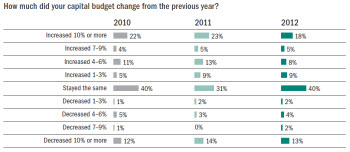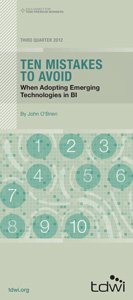 View online: tdwi.org/flashpoint
View online: tdwi.org/flashpoint





November 1, 2012
ANNOUNCEMENTS
NEW TDWI Best Practices Report:
High-Performance Data Warehousing
NEW TDWI Checklist Report:
Analytic Databases for Big Data
CONTENTS

Managers: Why Won’t They Just Get on Board?

Get Ready for Master Data Management

Is There a Cure-All for Business Analytics?

Mistake: Failing to Recognize that Emerging Technology Skills May Be Scarce

See what's
current in TDWI Education, Events, Webinars,
and Marketplace

Managers: Why Won’t They Just
Get on Board?
Lorna Rickard
Xtivia, Inc.
Topic:
Business Intelligence, Data Management, Program Management
Of all the potential issues related to full adoption of a business intelligence (BI) program, the thorniest are likely related to people. Getting business users to trust the data in the data warehouse and use new reports from the data warehouse, getting owners of source systems to allow access to their data, and getting people to change business processes are just a few of the many organization-wide change management issues that must be tackled to realize the BI vision for your organization.
The key to these types of issues is getting managers on board. There is no denying that managers stand dead center on the critical path that leads to acceptance and adoption of your BI initiative. They are the key conduit that will enable--or stall--the BI vision for your organization. How can you build awareness of and commitment to the BI program with this crucial group?
To lay the foundation, let’s start by taking a look at the world of middle managers. They exist between many different constituencies--employees, peers, senior managers, customers--each with different agendas and each trying to enlist the manager on their side. Negotiating the desires and demands of all of these groups is a daunting, but required, task of middle managers. This dynamic intensifies in periods of organizational change, such as the implementation of a BI program.
Senior leaders expect managers to support the changes enthusiastically, be an advocate of the change plans, and implement the required changes smoothly with their team. Their direct reports clamor for more information, for reassurance that their jobs are secure, and that they will receive adequate training in the new processes. Furthermore, they expect managers to advocate for their needs; they may even project their negative feelings about the change onto their managers.
Neither side recognizes that managers have to deal with the effects of the change program in their own lives and careers as well. It’s natural for managers to have many questions: Will this mean fewer managers and will I still have a job? Will this mean more work? How will that impact my personal life? How effectively will I handle any changes to my current tasks? How can I motivate my people now? Can I keep my top performers or will they leave? Where are the lines of communication and information?
The middle manager has to be both the swimmer and the lifeguard. There are four steps you can take to dramatically improve your manager’s abilities to be a change champion for the BI program as they address the array of challenges and opportunities before them.
- Begin communication with managers early. Research shows that a major reason managers resist change is that they don’t understand the business reasons for the change. Answer critical questions such as:
- Why is BI necessary?
- What do we expect to gain from BI?
- What are the risks of not implementing BI?
- How does it align with our vision?
- How have market changes, competitor threats, or customer issues influenced this decision?
- When does each phase of the plan need to be completed?
- Which departments will be most impacted?
- What training will be provided? When?
- How will this impact me? My team?
- Provide opportunities for managers to meet face-to-face with members of the project team--ideally including the executive sponsor--to ask questions, gain clarity, and voice concerns. This will go a long way toward educating and engaging them in the change.
- Train managers in change management. Allow them to first deal with their own issues and concerns, then help them learn how to manage these issues with their employees
- Provide managers with key messages that evolve and become more specific over time.
Slowing down and taking the time to educate and engage your managers in the forthcoming changes will dramatically increase the pace at which your BI program is accepted and adopted.
Lorna Rickard is the chief workforce architect with Xtivia, Inc., a consulting firm that specializes in data, technical, and organizational solutions for business intelligence.
References
Hiatt, Jeffrey M. [2006]. ADKAR: A Model for Change in Business, Government and Our Community, Prosci Learning Center Publications.
Oshry, Barry [2007]. Seeing Systems: Unlocking the Mysteries of Organizational Life, Berrett-Koehler.

Get Ready for Master Data Management
Patty Haines
Chimney Rock Information Solutions
Topic:
Data Management, Program Management
Master data, including customer and product data, is a critical component in a data warehouse and business intelligence environment. The accuracy and consistency of master data can greatly impact the value and contributions of a data warehouse. Many companies are implementing master data management (MDM) as a key component of their data management programs to improve the quality and value of their master data. However, there are numerous pitfalls to avoid when implementing these types of projects.
You should address the following areas when considering a master data management project to minimize the associated challenges and risks.
1. Identify project goals. First, identify your goals for implementing MDM as part of your data management program. Determine the type of master data within the organization and the main challenges the organization faces with this data. You must also understand the direction of your organization with respect to master data, considering such things as adding new master data to the environment through acquisition of new companies, reorganizing the current organizational structure, or working with multiple point-of-sale or back-office systems.
You must also understand whether the MDM solution needs to be able to merge multiple source records from multiple source systems. Furthermore, can your enterprise implement the business processes necessary to create and maintain the “best” record for each unique instance of a master data entity? These are key decisions that will impact the direction of the MDM project and the tools acquired and implemented as part of the MDM solution.
2. Project charter. After understanding the goals of the project, your next step is to create your project charter. This charter must be communicated to project team members and executives within your organization. The scope and goals of your MDM initiative must be well understood and accepted throughout your organization; MDM projects may significantly change the way operational systems and current business processes are defined and therefore may impact the way business units run the business. The business needs to understand and be part of this solution.
3. Data governance. Implementing a data governance program prior to the start of your MDM project is critical to your project’s success. Your organization needs to make key decisions, such as determining data ownership and defining the assignments and responsibilities of data stewards. Data needs to be prioritized to determine which data to start analyzing with possible business process changes for your organization. If your organization has not yet considered a data governance program, this step alone can be a limiting factor because it may take some time to get the data governance program operational.
4. Business participation. An MDM project is about business data and business processes, so your project team must include business staff as key team members. These team members will determine the type of business processes to implement to improve the creation of master data and the business rules to be applied to multiple sources to create the best record. The business team members know the data and what it means, so they can provide direction to the project team’s technical team members.
5. Understand your data. Early in your project you must profile and evaluate your organization’s master data to understand the accuracy, issues, and challenges of working with it. There may be inconsistencies in the way master data has been defined over time or you may find that multiple definitions exist for the same product because master records were (and continue to be) entered into the operational systems by different staff at different times.
The data analyst can begin this process by profiling key columns. The results can be analyzed with business team members to help understand the data and determine why it looks the way it does. It is important to understand the root cause for inconsistent data or multiply-defined data before determining how to change it, because changes may impact existing operational systems or business processes.
6. Acquire tools. Your project team will now know what type of tool it needs based on the goals of your project and the needs identified through your data governance program and profiling of the data and business processes. You can now evaluate and acquire the MDM tool.
Accurate, consistent, and complete master data is key to the use and value of data as an asset to the organization. Master data management projects that provide accurate, consistent, and complete master data can be challenging to implement because they involve and use a data governance program. These projects may also include changes to business processes and the implementation of new standards for the entire organization. Business involvement and executive sponsorship are necessary to successfully manage master data and implement master data management within your organization. The rewards will be well worth the challenges of helping your organization create and manage master data.
Patty Haines is founder of Chimney Rock Information Solutions, a company specializing in data warehousing and data quality. She can be reached at 303.250.3424.

Is There a Cure-All for Business Analytics?
Markus Ehrenmann, Roland Pieringer, and Kurt Stockinger
Data warehousing (DW) solutions show fundamental differences in their implementations, especially when comparing solutions across different industries. These differences raise the question of what typical industry-specific requirements look like and how they impact approaches to a solution.
In this article, we present a study of three brands representing business analytics in the fields of banking, telecommunications, and retail. We discuss analytical questions of the respective industries and provide an overview of the analytical requirements. We find that besides data volume, organizational characteristics such as number of employees or number of operational source systems have a significant influence on the solution and hence must be considered in the analysis. The biggest impact, however, on DW architecture stems from specific data integration requirements.
We discuss how the DW architectures of three exemplary brands meet these challenging conditions and highlight some of the main design choices, such as approaches for temporal features, key concepts, data sensitivity treatments, agility measures, and the management of their metadata and data quality. We discuss each of the solutions and show that there is no cure-all architecture that is optimal across different industries.
Read the full article and more: Download Business Intelligence Journal, Vol. 17, No. 3


Highlight of key findings from TDWI's wide variety of research
BI Benchmark Report: Budget
Capital budgets. Among organizations surveyed, capital spending on BI/DW infrastructure is up at 40 percent of organizations, indicating fairly widespread commitment to building out BI/DW infrastructure and meeting the demands of the big data era. However, capital budgets are down at 20 percent of organizations, a figure consistent with previous years, while capital spending remained unchanged at 40 percent of organizations. At $250,000, the median capital budget fell from $350,000 in 2011, but is up from the $150,000 median of 2010. Overall, capital spending appears to have recovered well after a pronounced decline during the 2009 recession.
Read the full report: Download 2012 TDWI BI Benchmark Report: Organizational and Performance Metrics for Business Intelligence Teams


FlashPoint Rx prescribes a "Mistake to Avoid" for business intelligence and data warehousing professionals.
Mistake: Failing to Recognize that Emerging Technology Skills May Be Scarce
John O’Brien
In most cases, adopting emerging technologies will require some degree of training or new roles to develop and support the implementation of the new technology. These resources may not be readily available in the market for hire, consultation, or contracting, or may only be available at a premium. Look internally and plan for roles and resources that may be good candidates for training and development opportunities. You should also check the availability of external training and be familiar with training programs available from the vendor.
Some technologies may utilize open standards languages or paradigms while others have proprietary or not-yet-standard languages. When evaluating several vendors and their products, existing internal skill sets must be part of your criteria. For example, Web services development will vary in programming language depending on the cloud service provider. Also, MapReduce programming must be learned as a paradigm for supporting big data and analytics, and the language and implementation may vary by big data vendor.
Consider mobile BI, which has the potential for incredible value in most companies but comes with broader IT infrastructure components for data security, app distribution stores, and device connectivity management. Additionally, BI teams will need to develop and understand the new skills and roles needed for user interface design, native app languages, HTML5, performance testing, and possibly data services.
Read the full issue: Download Ten Mistakes to Avoid When Adopting Emerging Technologies in BI (Q3 2012)







